Stepping stones
Stepping stones or stepstones are sets of stones arranged to form a simple bridge or causeway that allows a pedestrian to cross a natural watercourse, such as a river; or a water feature in a garden where water is allowed to flow between stone steps.[1] Unlike other bridges, they have no spans. Although their origin is unknown, stepping stones, along with log bridges, are likely to have been one of the earliest forms of crossing inland bodies of water devised by humans.
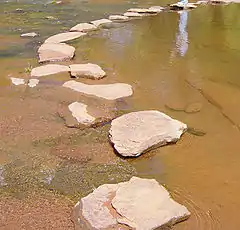 A rustic stepping stone bridge across a stream. | |
| Ancestor | None, this is one of the few foundational types, but see also: ford (crossing). |
|---|---|
| Related | Natural stepping stone stream crossing |
| Descendant | Clapper bridge, Zig-zag bridge, Log bridge |
| Carries | Pedestrians |
| Span range | Has no spans, but stones must be spaced to allow water flow and a comfortable step or leap |
| Material | Selected stone |
| Movable | No |
| Design effort | Low-rustic to Artisan applied art design |
| Falsework required | No |
In traditional Japanese gardens, the term "iso-watari" refers to stepping stone pathways that lead across shallow parts of a pond. Using iso-watari for crossing ponds, or shallow parts of streams, one can view the fish and plants around or in the pond, like carp, turtles, and waterfowls. It works like a bridge, in a slower way of crossing.
Today, stepping stones are commonly used by mountaineers and hikers as a makeshift way of crossing uncharted or unanticipated streams and torrents.
Historic stepping stones
The Drukken Steps in the Eglinton Woods of North Ayrshire in Scotland were a favourite haunt of poet Robert Burns and his companion Richard Brown, while the two were living in Irvine from 1781 to 1782.[2]
The name "Drukken" steps derives from a person's gait as they stepped from stone to stone whilst crossing the Red Burn. Seven or more stones were originally set in the Red Burn which was much wider than in 2009.[3]
Burns himself used the Scots spelling "Drucken" rather than "Drukken".[4] The ruins of the Drukken Steps are in the Eglinton Country Park.
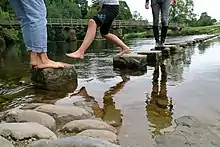 Stepping stones in Bolton Abbey
Stepping stones in Bolton Abbey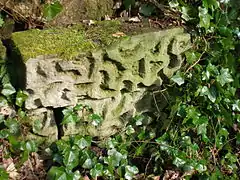 A stucco stone from The Drukken Steps, stepping stones in Scotland
A stucco stone from The Drukken Steps, stepping stones in Scotland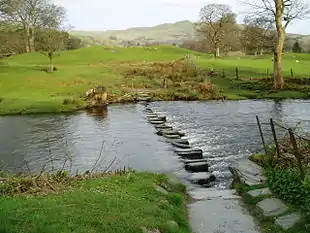 The stepping stones in the Rothay, Lake District, England
The stepping stones in the Rothay, Lake District, England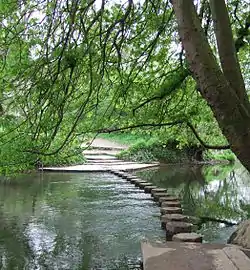
See also
- Clapper bridge
- Footbridge
- Ford (crossing)
- Kulgrinda
References
- "Glossary of Trail and Greenway Terms". South Carolina State Trails Program. 2008. Retrieved 5 January 2014.
- Love, Dane (2003), Ayrshire : Discovering a County. Ayr : Fort Publishing. ISBN 0-9544461-1-9
- King, Robert (2009). Oral Communication.
- Scotch Drink
External links
| Wikimedia Commons has media related to Stepping stones. |